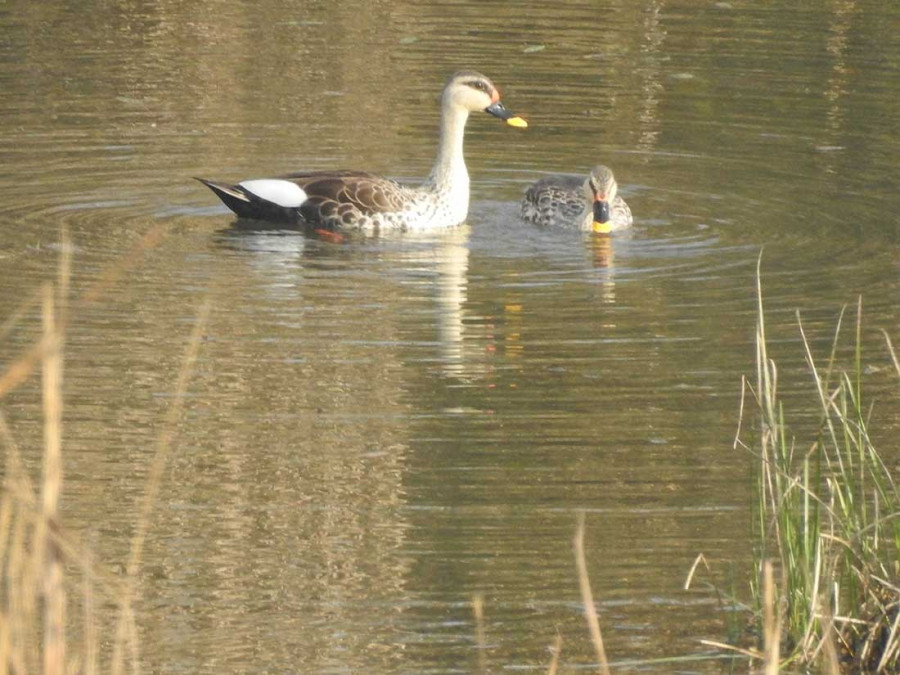
Indian spot-billed duck, locally called Nadon Hans, pictured at Ranital in the national park. Photo courtesy: National Trust for Nature Conservation
The Shuklaphanta National Park, a protected area in the Tarai of Sudurpaschim Province, is teeming with birds.
Greater scaup, locally called Kalo Tauke Hansa, a rare bird found in Nepal, has joined the latest list of rare aquatic birds in the park.
A bird count conducted in the national park in the first week of January has reported the first sighting of these rare birds in the park. According to Devraj Joshi, a technician with the Shuklaphanta Conservation Programme of the National Trust for Nature Conservation, some Greater scaup birds were found in Shikarital area of the Shuklaphanta National Park during the bird count.
“We could not ascertain their exact number but there were around 10 Greater scaups,” said Joshi, who has been actively involved in the bird count. “Never before has this bird species been seen in the park,” he said.
Similarly, Indian spot-billed duck, locally called Nadon Hansa, has also been spotted in Shuklaphanta area of Kanchanpur district after 13 years. The bird species was last seen in the park during the bird count of 2009. Joshi said they sighted two Indian spot-billed ducks in the area during the recent count.
According to bird conservationists, the thriving bird population in Shuklaphanta is a step forward in bird conservation efforts. Compared to last year, winter migratory bird numbers have increased by 50 percent in the park area this year.
A total of 6,478 water birds of 62 different species were recorded during the week-long bird count conducted through the head tracking method. “Around 4,000 aquatic birds of 60 species were reported in the Shuklaphanta area last year. The number of birds has increased in the area with two new species this year,” said Joshi.
The bird count was conducted in the national park and around a dozen wetlands and rivers in and around the protected area. Conservationists counted birds in nine lakes including Shikarital, Babatal, Ranital, Kalikichtal, Bathaniyatal, and Baunne river within the national park. Similarly, the bird count was carried out in Purainital and Bandatal wetlands and in Beldadi farmland outside the park. According to the Suklaphanta National Park, the highest number of aquatic birds were found in Kalikichtal inside the national park.
Red-crested pochard, locally called Sunjure Hansa, was found in highest numbers. A total of 1,124 such birds were found in the Shuklaphanta area.
The aquatic bird count was jointly conducted by the national park office, the National Trust for Nature Conservation, Zoological Society of London, Himali Prakriti, Bird Conservation Nepal, and Shuklaphanta Nature Guide Association among other conservation organisations. Several groups with 15 people each were formed and deployed in the wetlands area where they spent three hours a day identifying and counting birds. “The teams used cameras, binoculars and telescopes to conduct the count,” said Joshi.
According to bird conservationists, migratory birds begin descending to the Shuklaphanta area from October from colder climes and stay on till March.
Although the increase in the number of aquatic birds in the park this year is a good sign, there are still several challenges to overcome in the conservation of birds in the Shuklaphanta area. “There have been instances when miscreants have poisoned the birds to kill them for meat. Some birds were found dead in the Mahakali river last year. Some critically ill poisoned vultures were also rescued from the area last year,” said Laxmiraj Joshi, chief at Shuklaphanta Conservation Programme of the National Trust for Nature Conservation.
He underscored the importance of regular bird counts to identify challenges in bird conservation and to take preventive measures against threats.













